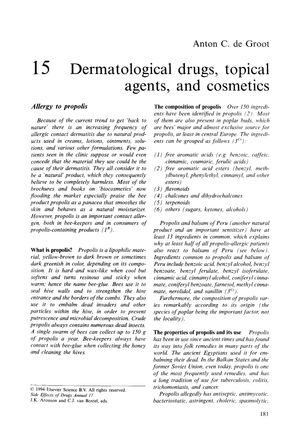Dermatological Drugs, Topical Agents, and Cosmetics
January 1993
in “
Side effects of drugs annual
”
PUVA treatment psoriasis PUVA keratosis lupus erythematosus retinoids hepatotoxicity skeletal changes peripheral neuropathy etretinate acitretin isotretinoin pseudoporphyria photoallergic reactions median canaliform dystrophy ectropion acute Achilles tendonitis teratogenicity corticosteroids mercury allergy oral lichen planus nail varnish allergies toluene sulfonamide/formaldehyde resin photoallergic contact dermatitis sunscreen agents oxybenzone PUVA retinoids etretinate acitretin isotretinoin corticosteroids oxybenzone

TLDR Natural products like propolis are causing more skin allergies, and certain skin treatments and medications have various side effects and risks.
In 1993, it was reported that there was an increase in allergic contact dermatitis from natural products, with propolis identified as a significant allergen, affecting 4.2% of 605 patients in Prague and 1.2% of 3177 patients in Hamburg. The document also highlighted the risks associated with PUVA treatment for psoriasis, including PUVA keratosis and the potential unmasking of lupus erythematosus, as well as various side effects of retinoids such as hepatotoxicity, skeletal changes, and peripheral neuropathy. Etretinate was being replaced by acitretin due to its long half-life and teratogenic properties. Isotretinoin use was linked to pseudoporphyria, photoallergic reactions, median canaliform dystrophy, ectropion, and acute Achilles tendonitis, and its teratogenicity was emphasized. Contact allergy to corticosteroids was reported in 4.1% and 2.9% of patch-tested patients, and a potential link between mercury allergy and oral lichen planus was suggested. Nail varnish allergies, particularly to toluene sulfonamide/formaldehyde resin, were noted, and patch testing was recommended for drug eruptions. The document also mentioned the rise in photoallergic contact dermatitis, with sunscreen agents like oxybenzone being common causes.



